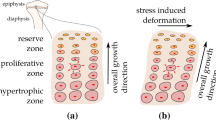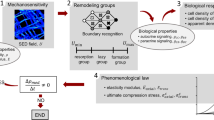Abstract
Mechanobiological growth is the process whereby bone growth is modulated by mechanical loading. Analytical formulations of mechanobiological growth have been developed by Stokes et al. (J Orthop Res 17(5):646–653, 1990) and Carter et al. (J Orthop Res 6:804–816, 1988). The purpose of this study was to compare these two modeling approaches in a finite element model of a vertebra to investigate whether growth pattern induced by these models were equivalent. A finite element model of a thoracic vertebra, integrating a conceptual model of the growth plate, was developed and combined with the mechanobiological growth models. This model was further used to simulate vertebral growth modulation resulting from different physiological loading conditions. Different growth magnitudes were obtained under compression and combined tension/shear loading, whereas dissimilar growth patterns were triggered by shear forces and combined compression/shear. These two models represent mechanobiological bone growth under limited mechanical environment. Carter’s model takes into account three-dimensional stress stimuli, but does not intrinsically incorporate the resulting growth orientation. Stokes’ model adequately represents the mechanobiological contribution of axial stresses but does not take into account the contribution of non-axial stresses, which can occur in complex mechanical environment.






Similar content being viewed by others
References
Alberty A, Peltonen J, Ritsila V (1993) Effects of distraction and compression on proliferation of growth plate chondrocytes. A study in rabbits. Acta Orthop Scand 64:449–455
Beaupre GS, Stevens SS, Carter DR (2000) Mechanobiology in the development, maintenance and degeneration of articular cartilage. J Rehabil R D 37:145–151
Bonnel F, Dimeglio A, Baldet P, Rabischong P (1984) Biomechanical activity of the growth plate. Clinical incidences. Anat Clin 6:53–61. doi:10.1007/BF01811214
Carrier J, Aubin CE, Villemure I, Labelle H (2004) Biomechanical modeling of growth modulation following rib shortening or lengthening in adolescent idiopathic scoliosis. Med Biol Eng Comput 42(4):541–548. doi:10.1007/BF02350997
Carter DR, Wong M (1988) The role of mechanical loading histories in the development of diarthrodial joint. J Orthop Res 6:804–816. doi:10.1002/jor.1100060604
Carter DR, Wong M (1988) Mechanical stresses and endochondral ossification in the chondroepiphysis. J Orthop Res 6(1):148–154. doi:10.1002/jor.1100060120
Dimeglio A, Bonnel F (1990) Le rachis en croissance. Springer, Paris, p 453
Farnum CE, Wilsman NJ (1998) Growth plate cellular function. In: Buckwalter JA, Ehrlich MG, Sandell LJ, Trippel SB (eds) Skeletal growth and development. AAOS, Rosemont, pp 203–243
Farnum CE, Wilsman NJ (1998) Effects of distraction and compression on growth plate function. In: Buckwalter JA, Ehrlich MG, Sandell LJ, Trippel SB (eds) Skeletal growth and development. AAOS, Rosemont, pp 517–530
Farnum CE, Nixon A, Lee AO, Kwan DT, Belanger L, Wilsman NJ (2000) Quantitative three-dimensional analysis of chondrocytic kinetic responses to short-term stapling of the rat proximal tibial growth plate. Cells Tissues Organs 167(4):247–258. doi:10.1159/000016787
Frost HM (1990) Skeletal structural adaptations to mechanical usage (SATMU): 3. The hyaline cartilage modeling problem. Anat Rec 226(4):423–432. doi:10.1002/ar.1092260404
Kim CH, You L, Yellowley CE, Jacobs CR (2006) Oscillatory fluid flow induced shear stress decreases osteoclastogenesis through RANKL and OPG signaling. Bone 39(5):1043–1047. doi:10.1016/j.bone.2006.05.017
Lerner AL, Kuhn JL, Hollister SL (1998) Are regional variations in bone growth related to mechanical stress and strain parameters. J Biomech 31:327–335. doi:10.1016/S0021-9290(98)00015-3
Leveau BF, Bernhardt DB (1984) Developmental biomechanics. Effect of forces on the growth, development, and maintenance of the human body. Phys Ther 64:1874–1882
Mao JJ, Nah HD (2004) Growth and development: hereditary and mechanical modulations. Am J Orthod Dentofacial Orthop 125(6):676–689. doi:10.1016/j.ajodo.2003.08.024
Mehlman CT, Araghi A, Roy DR (1997) Hyphenated history: the Hueter–Volkmann Law. Am J Orthop 26(11):798–800
Moreland MS (1980) Morphological effect of torsion applied to growing bone. J Bone Joint Surg Br 62-B(2):230–237
Price JS, Oyajobi BO, Russell RGG (1994) The cell biology of bone growth. Eur J Clin Nutr 48(suppl 1):131–149
Sarwark J, Aubin CE (2007) Growth considerations of the immature spine. J Bone Joint Surg Am 89(suppl 1):8–13. doi:10.2106/JBJS.F.00314
Schmidt H, Kettler A, Heuter F, Simon U, Claes L, Wilke HJ (2007) Intradiscal pressure, shear strain, and fiber strain in the intervertebral disc under combined loading. Spine 32(7):748–755. doi:10.1097/01.brs.0000259059.90430.c2
Schwartz L, Maitournam H, Stolz C, Steayert JM, Ho Ba Tho MC, Halphen B (2003) Growth and cellular differentiation: a physica-biochemical conundrum? The example of the hand. Med Hypotheses 61(1):45–51. doi:10.1016/S0306-9877(03)00102-6
Shefelbine SJ, Carter DS (2004) Mechanobiological prediction of growth front morphology in development hip dysplasia. J Orthop Res 22:346–352. doi:10.1016/j.orthres.2003.08.004
Shefelbine SJ, Carter DS (2004) Mechnobiological predictions of femoral anteversion in cerebral palsy. Ann Biomed Eng 32(2):297–305. doi:10.1023/B:ABME.0000012750.73170.ba
Shefelbine SJ, Tardieu C, Carter DR (2002) Development of the femoral bicondylar angle in hominid bipedalism. Bone 30(5):765–770. doi:10.1016/S8756-3282(02)00700-7
Stevens SS, Beaupre GS, Carter DS (1999) Computer model of endochondral growth and ossification in long bones: biological and mechanobiological Influences. J Orthop Res 17(5):646–653. doi:10.1002/jor.1100170505
Stokes IAF (2007) Analysis and simulation of progressive adolescent scoliosis by biomechanical growth modulation. Eur Spine J 16:1621–1628. doi:10.1007/s00586-007-0442-7
Stokes IAF, Laible JP (1990) Three-dimension osseo-ligamentous model of the thorax representing initiation of scoliosis by asymmetric growth. J Biomech 23(6):589–595. doi:10.1016/0021-9290(90)90051-4
Stokes IAF, Aronsson DD, Urban JPG (1994) Biomechanical factors influencing progression of angular skeletal deformities during growth. Eur J Musculoskelet Res 3:51–60
Stokes IAF, Mebte PL, Iatridis JC, Farnum CE, Aronsson DD (2002) Enlargement of growth plate chondrocytes modulated by sustained mechanical loading. J Bone Joint Surg Am 84:1842–1848
Stokes IAF, Gwadera J, Dimock AN, Farnum CE, Aronsson DD (2005) Modulation of vertebral and tibial growth by compression loading: diurnal versus full-time loading. J Orthop Res 23:188–195. doi:10.1016/j.orthres.2004.06.012
Stokes IAF, Aronsson DD, Dimock AN, Cortright V, Beck S (2006) Endochondral growth in growth plates of three species at two anatomical locations modulated by mechanical compression and tension. J Orthop Res 24(6):1327–1334. doi:10.1002/jor.20189
Stokes IAF, Clark KC, Farnum CE, Aronsson DD (2007) Alterations in the growth plate associated with growth modulation by sustained compression or distraction. Bone 41:197–205. doi:10.1016/j.bone.2007.04.180
Sylvestre PL, Villemure I, Aubin CE (2007) Finite element modeling of the growth plate in a detailed spine model. Med Biol Eng Comput 45(10):977–988. doi:10.1007/s11517-007-0220-z
Trepczik B, Lienau J, Schell H, Epari DR, Thompson MS, Hoffmann JE, Anke KR, Mundlos S, Dudam GN (2007) Endochondral ossification in vitro is influenced by mechanical bending. Bone 40:597–603. doi:10.1016/j.bone.2006.10.011
Van Der Meulen MCH, Huiskes R (2002) Why mechanobiology? A survey article. J Biomech 35:401–414. doi:10.1016/S0021-9290(01)00184-1
Villemure I, Aubin CE, Dansereau J, Labelle H (2002) Simulation of progressive deformities in adolescent idiopathic scoliosis using a biomechanical model integrating vertebral growth modulation. ASME J Biomech Eng 124:784–790. doi:10.1115/1.1516198
Villemure I, Aubin CE, Dansereau J, Labelle H (2004) Biomechancial simulations of the spine deformation process in adolescent idiopathic scoliosis from different pathogenesis hypotheses. Eur Spine J 13(1):83–90. doi:10.1007/s00586-003-0565-4
Villemure I, Chung MA, Seck CS, Kimm M, Matyas JR, Duncan NA (2005) Static compressive loading reduces the mRNA expression of type II and X collagen in rat growth-plate chondrocytes during post-natal growth. Connect Tissue Res 46(4–5):211–219. doi:10.1080/03008200500344058
Wang X, Mao JJ (2002) Chondrocyte proliferation of the cranial base cartilage upon in vivo mechanical stresses. J Dent Res 81:701–705
Wang Y, Middlecton F, Horton JA, Reichel L, Farnum CE, Damron TA (2004) Microarray analysis of proliferative and hypertrophic growth plate zones identifies differentiation markers and signal pathways. Bone 35:1273–1293. doi:10.1016/j.bone.2004.09.009
Acknowledgments
This project was funded by the Canada Research Chair Program, the Canadian Institutes of Health Research (CHIR), and the CIHR-MENTOR Program.
Author information
Authors and Affiliations
Corresponding author
Rights and permissions
About this article
Cite this article
Lin, H., Aubin, CÉ., Parent, S. et al. Mechanobiological bone growth: comparative analysis of two biomechanical modeling approaches. Med Biol Eng Comput 47, 357–366 (2009). https://doi.org/10.1007/s11517-008-0425-9
Received:
Accepted:
Published:
Issue Date:
DOI: https://doi.org/10.1007/s11517-008-0425-9




